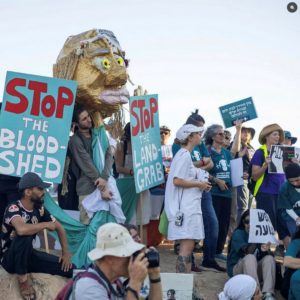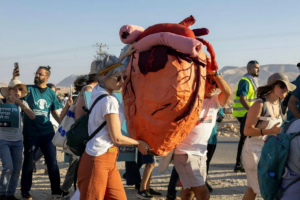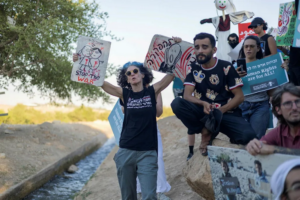‘It’s my duty’: What brings these activists to a Palestinian town in the Jordan Valley

Activists on the way to al-Auja near Jerico, 31 August 2024
Linda Dayan reports in Haaretz on 8 September 2024:
On the ride to al-Auja, a Palestinian town north of Jericho, about fifty Israeli peace activists jotted down their names, phone numbers and ID numbers on a sheet of paper. It was the last Saturday of August and they were about to begin a protest march against settler violence with 150 other activists, both Israeli and Palestinian.
Should one of the participants be arrested during the protest, explained Mia Biran, the Israeli program manager of the anti-occupation NGO Combatants for Peace over the bus loudspeaker, the information will help the group locate them and provide legal aid. “The march isn’t coordinated [with the army], because there’s no way we would have gotten approval. Like nearly all things that happen in the West Bank, like building, this isn’t legal. There’s no way for it to be legal,” she said.
The impetus for the protest was the ongoing attempts by Israeli settlers to prevent the area’s residents from accessing the al-Auja stream, which flows between the dusty banks of the Jordan Valley. It is a source of water for the community as well as a rare place of respite, and has been a site of settler provocation since October 7.
“We’re Israelis and Palestinians who have come to say, ‘no more occupation, no more war, no more settler violence, no more military violence, no more stealing resources from Palestinians who live in the West Bank and outside of it,” Biran said.
The march, which was organized by Combatants for Peace, was to be wholly nonviolent. “We don’t want to clash with anyone,” Biran announced – not the army and not any settlers who may come through. “It’s not just important for us, but for the residents of al-Auja and Ras Ayn al-Auja, which is nearby. If we make any commotion, they’re the ones who have to cope with it,” she said, urging participants to comply with any requests from the army or police. In the meantime, she instructed participants to lock their phones in the event that they are confiscated by soldiers.
On the bus was Ma’ayan, a 24-year-old student from Jerusalem who immigrated to Israel from South America about a decade ago. She explained that while the specter of settler violence frightens her, it’s important to take part in the protest. “I can speak up, and worst-case scenario – at the moment at least – I’m gonna go to prison for a day or something,” she said. “And Palestinians and other people don’t have the same privilege as me, so I find that it’s a duty to do it.”
A little while earlier, an activist named Alma and her cohorts from Women Sit For Peace, a group of white-clad women who host anti-war sit-ins, loaded a massive sculpture of a human heart into the bus’s luggage hold – they would carry it during the march. “We prepared the heart a few months ago, as a group. It was a couple of months into the war, and we felt that it was very hard for us to just sit around while we saw such a terrible massacre go on, and while hostages weren’t returning from Gaza. We wanted to bring the message of sanctifying life at a time when it feels like just death is being sanctified,” she explained.

Women from Women Sit For Peace, a group of white-clad women who host anti-war sit-ins, carry a sculpture of a human heart
After a couple of hours of driving past small towns, Palestinian factories, Israeli date groves and hilltop settlements topped with stars of David, the bus parked on the side of the road. Next to the al-Auja stream, activists mingled. A bus full of Israelis from Jerusalem had just arrived, as had a minibus with alumni of the Palestinian Freedom School, a Palestinian youth program affiliated with Combatants for Peace. Organizers doled out dark green t-shirts and protest signs, and Palestinian groups brought out massive puppets decked out in traditional garb.
Israeli soldiers had also arrived. “Shabbat shalom, thank you for coming,” said one with a smile. He was sporting a kippah and a long beard. “I just ask that you keep off of the road.” A younger soldier, a woman, herded attendees off the asphalt more sternly. The protesters and organizers complied, calling out instructions to stay off the narrow street through megaphones.
Nonviolent communication
Sayel Jabareen, an activist from Ramallah who serves as Combatants for Peace’s Palestinian campaigns manager, carried a large cutout of Handala, an iconic cartoon figure symbolizing Palestinian refugees. “This is Area C; some would call it the civil administration. It is a Palestinian area, a Bedouin area,” he explained, adding that it “is the only place the families can come and hike and escape the summer heat.” Since October 7, however, “the settlers are preventing any Palestinians from coming here, whether it’s to take walks, to bathe in the stream, or even to shepherd their flocks. We see threats from settlers all the time, even at night.”
He added, “We came here together – Palestinians and Israelis from all over the land – to prove to the managers of the occupation that we don’t want violence, we can live together, we can march together. We’re demanding freedom for everyone, justice and equality for everyone.”
Missing from the march, however, were the Palestinian residents of al-Auja themselves, who had been encouraged not to join in out of fear that protesting could make them targets for reprisals if local settlers recognized them.
This protest was advertised as women-led, and Mai Shahin, a peace activist from the town of Bethany, also known as al-Eizariya, near East Jerusalem, urged women to the front of the crowd. She led chants in Arabic and English. “We are here in solidarity, in nonviolent resistance,” she called. “Women-led is women [supporting] everyone – all the children are our children!” One hundred families, she shouted, live in the area with no access to the spring, cut off from water resources and from the rest of the West Bank. “So we are here to say: From the river to the sea – everyone shall be free!”
A translator by trade, Shahin found herself working with Ecome, an Israeli-Palestinian community space and movement that championed nonviolent communication in ending the conflict. Although it closed six years ago, Shahin told Haaretz, she and a few others came together in the spring to establish Satyam, a program and space in a similar vein. “In this war, it was very obvious that a big part of what keeps happening to us is due to this separation, where we don’t come together anywhere. We don’t sit, we don’t agree, we don’t talk, we don’t heal. So we again decided to take the courageous step and say ‘yallah – we’ll open it wherever we find a home, and we’ll take it from there.'”
The home the organization found is a spacious building in Beit Jala, near Bethlehem. There, they host Palestinians and Israelis for training sessions in nonviolent communication, trauma, grief and women’s circles. It is also close to the area of al-Makhrour, which has also seen settler violence and land grabs by the Israeli government, and has become a hub of activism.
Although some Israelis may be afraid to cross into Palestinian territory, and some Palestinians may be afraid to work with Israelis, Shahin insists that it’s a fear worth overcoming. “It’s worth all of the shakiness, worth all of the doubts, worth everything just to step in, to see, to allow [yourself] to be seen,” she said. “This is why we use nonviolent communication – to show people the capacity and the ability and the need for everyone, from the river to the sea, to be free.”

Protesters along the banks of the al-Auja stream on 31 August 2024
She added, “This fear is exactly the fear that the systems put on us, this enemy image toward each other. And it is time for us to conquer this fear. It is time to say, ‘No, I will not accept this system that separates me, and I will understand that every time there is separation, there is something not right and dehumanizing [going on].”
With Shahin at the forefront and soldiers keeping pace along the road, the activists walked toward the mouth of the stream. They chanted in Arabic, “Yes, yes, yes to peace! No, no, no to occupation!” An Israeli woman sang a soft melody, an English-language prayer for water, into the loudspeaker. The participants, who seemed to range in age from late teens to grandparents, laughed as they stumbled over rocks and groaned in the desert heat.
“I came to al-Auja to speak in solidarity with the people here, who are not allowed to use this water for their land,” said Reyan, a 20-year-old from Ramallah who had come with the Palestinian Freedom School. “I believe in nonviolent resistance, and the woman leadership is very important in nonviolence. It’s such an honor to stand here and be with the women, all of them – not just the Palestinians, all the Israelis, everyone here. Connecting and being here means so much to me.”
‘In the end, you need to talk’
At the mouth of the stream – the site where local Palestinians are reportedly barred from hiking and bathing – the organizers stopped the march. Directed by Shahin, who led more chants, they stood on rocks to deliver speeches to the crowd.
Jamil Qassas, the Palestinian general coordinator of Combatants for Peace, took the makeshift stage. “The extremists won’t divide us – not the Israelis and not the Palestinians,” he said in fluent Hebrew. “I know that we’re all in a very difficult situation. The war in Gaza has been raging for nearly a year, with many people killed – over 40,000 Palestinians there – and on the other side too there are a few thousand. War and racism will not lead us to a place of recovery for life and for peace. I think we all see this great darkness, and we are all searching for light. I can tell you all, you are the light we are looking for, so be the light for all of us!” He delivered a similar speech in Arabic.
Qassas has a personal understanding of the violence of the conflict, and its toll. He has lost three family members to the bloody cycle: his grandfather in 1948, his uncle as a member of the Palestinian militias in the First Lebanon War, and his then-14 year-old brother, who was running away from the soldiers he met along the road during the first intifada. During that time, Qassas was an organizer with a PFLP-affiliated group, “an organization that to this day doesn’t recognize the peace agreements.” He was wanted by Israel, and was wounded twice by IDF fire.
Jamil Qassas has lost three family members to the bloody cycle: his grandfather in 1948, his uncle as a member of the Palestinian militias in the First Lebanon War, and his then-14 year-old brother, who was running away from soldiers he met along the road during the first intifada. “As I see it, I experienced all that violence, and I know what it means. After so much violence and what I did during the first intifada, I came to the conclusion that I didn’t feel like I’d made a difference – not for my people, and not on the other side,” he said. “Today, at least, when I sit with my Israeli partners, with an Israeli audience, I explain the reality here, I explain that we’ve been fighting each other for 75 years with no change and no success, not for Israelis and not for Palestinians. I think that every occupation that has ended and every war that has ended did so on the [negotiating] table. In the end, you need to talk.”
‘The conflict is not between Israelis and Palestinians’
Also on the roster of speakers was Knesset member Ofer Cassif, from left-wing Arab and Jewish party Hadash-Ta’al. “Israeli-Palestinian solidarity is the way – it is the only way to a future for all of us, for both nations. It is the only way to achieve justice,” he said. “The path to achieving justice must pass through immediately ending the awful attacks, the massacre in Gaza. It must pass through ending settler terror in the occupied territories, because what we see here in the control over water sources, in the violent distancing of Palestinians from their water is no less than terror.”
He also delivered a few words in English, concluding that, “The conflict is not between Israelis and Palestinians; it is between those who do evil and those who struggle for justice. We are on the side of justice – we shall prevail!”
Soon after, jeeps arrived with dozens more soldiers. “This is a closed military zone,” they declared over their loudspeakers. “Make your way to your cars now.” The organizers were quick to respond, and to shepherd the crowd back to the starting point, carefully minding the road. Back at the site were Israeli police, who were searching the outsides of private vehicles parked by the road, looking for infractions – and finding them. The owners would have to pay the tickets, and the police would have a record of the Israeli cars that were there.
But despite the setback, the organizers and attendees felt a sense of success. “The march was very diverse. A lot of Israelis, a lot of Palestinians, a lot of Christians and a lot of Muslims. I think it was a majority female, women-led protest as we planned. And I think it went really well. We went to march from the very beginning until we got to the area of the water, which is the reason behind the protest,” said Amira Mohammed, an activist from East Jerusalem and co-host of the Third Narrative podcast. “Obviously, some things were out of our control, such as the weather and the way that the army decided to behave. There was no violence at all, or visually apparent incitement from them, but they did make it very, very difficult to continue the very peaceful march.”
This article is reproduced in its entirety
